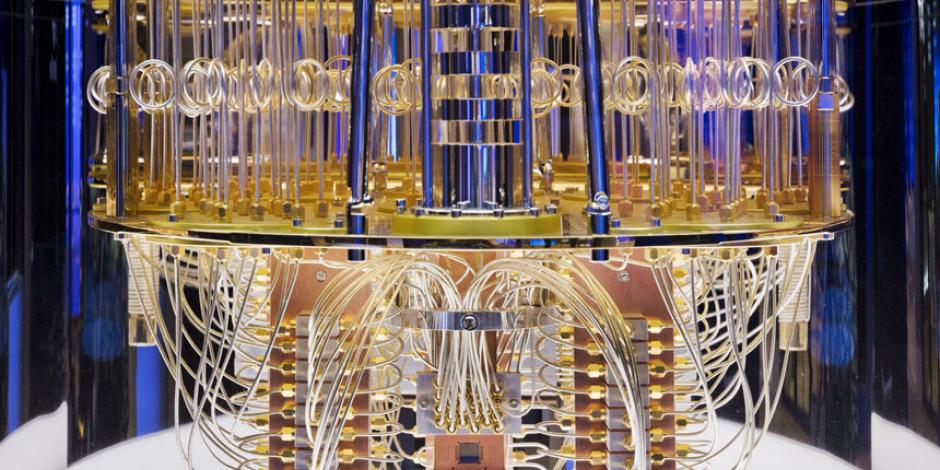entangledverwickelt, verheddert; hier: verschränktModern-day computers are very fast. Users can visit a website, edit sth.etw. bearbeitenedit a photo or load a game in seconds. But researchers and businesses working on highly complex problems need more speed — much more. This is why big tech companies are building an entirely new type of computer: a quantum computer. In 2019, Google proved it was possible, building an experimental quantum computer that performed a task in a few minutes that, they said, a supercomputer couldn’t do in 10,000 years.
Dr Heike Riel, an IBM fellowhier: vom Vorstand ernannte(r) Berater(in) und Mentor(in) in einem Fachgebietfellow and department headhier: Fachgebietsleiter(in)department head, science and technology, at IBM Research Europe, told Business Spotlight: “Quantum computers to tap into sth.etw. erschließentap into a completely different way to manipulate information, using quantum mechanical phenomena.” quantum computingQuantenrechnenQuantum computing is based on more than 100 years of research in quantum mechanicsQuantenmechanikquantum mechanics, a field of physics that studies the subatomic worldhier: subatomare Quantenweltsubatomic world. Experts say it could revolutionize medicine, develop new materials, secure private data and much more. But how does it work? While the science behind quantum computing is to be mind-bendingbewusstseinsverändernd; hier: schwierig zu verstehen seinmind-bending, it’s possible to understand some key differences between quantum computers and the conventional ones in use today.
The quantum quality
Computers use small units of data called “bits”. “A bit can be in one of two stateZustandstates at any given time,” Dr Harun Šiljak, an assistant professor at the school of engineeringFakultät für IngenieurwesenSchool of Engineering, Trinity College Dublin, told Business Spotlight. “Either 0 (off) or 1 (on).” Apps, websites, photos — everything on a computer or phone is made up of billionMilliarde(n)billions of these bits in 0s or 1s. However, a quantum computer uses “qubits” (“quantum bits”). “A qubit can be in those two states at the same time,” Dr Šiljak says. “This is called a ‘superpositionÜberlagerungsuperposition of states’.”
“A classical bit is like a coin lying on the table, with one side facing up,” Dr Šiljak says. The qubit, however, is more like a coin that’s been to flip sth.hier: etw. werfenflipped in the air. It’s not possible to see if it’s heads or tailsKopf oder Zahlheads or tails. “It’s heads and tails,” Dr Šiljak says, “at least until you can have a closer look.”
In addition to the superposition of states, qubits can also be “entangled”. Imagine flipping two coins at the same time. If the coins are entangled, the results are not separate but influence each other. Even physicists still aren’t sure why entanglement works the way it does, but it allows qubits to be combined to make larger calculations.
With more and more qubits, the number of possible states multiplies exponentially: three bits can be in only three states, for example, while three qubits can be in a superposition of eight (000, 111, 100, 010, 001, 110, 011, 101). This is how a quantum computer can solve complex problems much quicker than an ordinary computer could.
Closer look: The most famous cat in physics
In 1935, Austrian-Irish physicist Erwin Schrödinger, one of the fathers of quantum theoryQuantentheoriequantum theory, created his thought experiment about a cat that is both alive and dead. It is a metaphor for the superpositionÜberlagerungsuperposition of stateZustandstates, with which Schrödinger wanted to demonstrate the difficulty of interpreting quantum theory. He could never have imagined that his idea would become a global merchandising hit, inspiring T-shirts, memeMemememes and much more. Even today, physicists and philosophers are still to argue about sth.über etw. debattierenarguing about what Schrödinger’s cat really means.
Are there practical applications?
Imagine a logistics company wants to move its fleet of lorries from one side of a city to another in the shortest time possible. It’s necessary to work out the best route through roads, traffic jams, detourUmleitungdetours for roadworks, etc. An ordinary computer will try each route in turn, ruling out one after another, until it finds the best one. A quantum computer, however, can try every possible route at once. According to IBM, if you had to find one itemSache, Postenitem in a list of a trillionBillion(en)trillion items and it took a microsecond to look at each item, a conventional computer could find it in about a week, while a quantum computer would find it in one second.
So, will everyone need a quantum computer in the future? Dr Riel says quantum computers aren’t intended to replace personal computers. Physicist Dr Shohini Ghose described this in her 2018 TED Talk: “A quantum computer is not just a more powerful version of our current computers — just like a light bulbGlühbirnelight bulb is not a more powerful candle. You cannot build a light bulb by building better and better candles. A light bulb is a different technology, based on deeper scientific understanding. Similarly, a quantum computer is a new kind of device, based on the science of quantum physics.”
Quantum computers offer real benefits only for very specific tasks. They’ll often be used remotely to explore and solve particular problems — although the solutions they find may one day transform industries. Dr Riel says that complex problems across the underlying chemistry of materials and drug designWirkstoffdesigndrug design, for example, could lead to new medicines for diseases that are currently untreatable.
As with AI (artificial intelligence)KI (künstliche Intelligenz)AI, there’s a concern that, in the wrong hands, quantum computers could do a lot of damage. They can to break sth. downhier: etw. aufschlüsselnbreak down the vastenorm, gewaltigvast numbers used in existing encryptionVerschlüsselungencryption systems, for example, putting data at risk. However, quantum encryption keyVerschlüsselungscodeencryption keys, which use the uncertainty of superposition, could also make data security completely impenetrableundurchdringlich, unüberwindlichimpenetrable in the future.
Do you speak subatomic?
Scientists have to detect sth.etw. aufspürendetected more than 200 subatomic particles, the building blockBausteinbuilding blocks of all matterMateriematter. Here are just a few:
Photon: the smallest amount of electromagnetic energy a single particle of light at a certain wavelengthWellenlängewavelength can carry
Neutron: a subatomic particle found in the nucleus (pl. nuclei)Kernnuclei of most atoms. It has no electrical chargeLadungcharge and is always neutral
Electron: a subatomic particle that makes up most of the volume of an atom. It acts as the primary carrier(Ladungs-)Trägercarrier of electricity and has a negative charge
Quarks: even smaller elementary particles found inside protons and neutrons
Neutrino: another elementary particle found inside electrons and other places
The faster, the better
This is only the beginning. Quantum computing could benefit any complex problem that needs to test many possibilities. Widespread use of the technology is still years away, but a few companies are using it already. Dr Riel says that IBM is currently working with Daimler, for example, to discover how quantum computing might help to develop new battery materials, optimize manufacturing processes and improve self-driving vehicles. Similarly, the energy company E.ON is exploring ways to optimize the integration of renewableserneuerbare Energienrenewables into existing energy infrastructure. “Quantum computers could help solve such difficult optimization problems more efficiently,” Dr Riel says.
To reach their full potential, however, quantum computers will need the ability to form a network. A team at the Delft University of Technology, in the Netherlands, took a step towards that this year, sending data across three physical locations with a technique called “quantum teleportation”. Delft physicist Ronald Hanson told The New York Times: “We are now building small quantum networks in the lab, but the idea is to eventually build a quantum internet.”
While everyone can understand that quantum computing has vast potential, the science behind it is dauntinglyin beängstigender Weisedauntingly complex. Dr Ghose says: “We do not experience this fluidfließend; hier: veränderlich, sich wandelndfluid quantum reality in our everyday lives. So, if you are confused by quantum, don’t worry, you’re to get sth. (ifml.)etw. verstehen, kapierengetting it.”
Neugierig auf mehr?
Dann nutzen Sie die Möglichkeit und stellen Sie sich Ihr optimales Abo ganz nach Ihren Wünschen zusammen.



